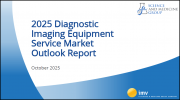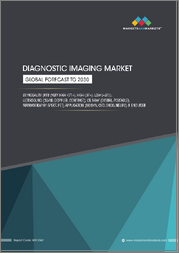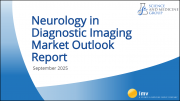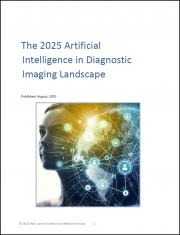
|
시장보고서
상품코드
1587463
관상동맥성 심질환 진단 영상 기기 시장 규모, 점유율, 동향 분석 보고서 : 모달리티별, 지역별, 부문별 예측(2025-2030년)Coronary Heart Disease Diagnostic Imaging Device Market Size, Share & Trends Analysis Report By Modality (Computed Tomography, X-rays, Ultrasound, Magnetic Resonance Imaging, Nuclear Medicine), By Region, And Segment Forecasts, 2025 - 2030 |
||||||
관상동맥성 심질환 진단 영상 기기 시장 성장 및 동향:
Grand View Research, Inc.의 최신 보고서에 따르면, 세계 관상동맥성 심질환 진단 영상 기기 시장 규모는 2025년부터 2030년까지 연평균 6.6%의 CAGR을 기록하며 2030년까지 29억 6,000만 달러에 달할 것으로 예상됩니다.
관상동맥 질환과 그에 따른 사망률 증가로 인해 더 나은 조기 진단이 요구되고 있습니다. 정확한 스캔 해석과 기술적으로 진보된 장비가 시장 성장에 영향을 미치는 요인입니다. 다양한 영상 진단 방법은 관상동맥 스크리닝의 고유한 측면을 파악하는 데 유용합니다. 예를 들어, 혈관내 초음파, X선 혈관조영술, 컴퓨터 단층촬영(CTCA)은 관상동맥의 변화를 직접적으로 평가하고 정량화합니다. 그러나 단광자 컴퓨터 단층촬영(SPECT)이나 양전자방사단층촬영(PET)과 같은 비침습적 기술은 관상동맥 질환의 결과로 발생하는 심근의 관류 및 대사 이상을 추정하여 CHD에 대한 간접적인 정보를 제공합니다.
이 분야의 기술 발전은 카드뮴 아연 텔루르화 카드뮴(CZT) 반도체 검출기를 사용하는 감마 시스템으로 구성된 선명한 카메라 유닛의 개발로 이어졌습니다. 이를 통해 기존의 SPECT를 이용한 심근 관류 영상 촬영에 비해 이미지 획득 속도, 촬영 시간 단축, 이미지 품질 향상, 저선량(1회 주입 시 1mSv)을 실현했습니다. 또한, 컴퓨터 단층 촬영의 개선으로 비침습적인 방법이 개발되어 향후 이 분야의 성장도 기대되고 있습니다. 그러나 경제적 장벽, 피험자의 문해력, 의료진 부족으로 인해 이러한 첨단 기술이 실제 진료에 도입되는 데 어려움을 겪고 있습니다.
관상동맥성 심질환 진단 영상 기기 시장은 2020년 COVID-19 사태로 인해 급감했습니다. 바이러스 확산에 대한 두려움, COVID-19 환자의 진단과 치료에 대한 집중, 다른 질환의 입원율 감소, 의료진 감소 등이 CVD 진단 감소로 이어졌습니다. 최종사용자가 관찰 한 경제적 후퇴도 관상동맥 변화를 효과적으로 진단하는 첨단 기술의 채택에 영향을 미쳤습니다. 또한 국가 폐쇄로 인한 제조 장비 중단, 물류 중단 및 영업 인력 감축도 시장에 부정적인 영향을 미쳤습니다.
관상동맥성 심질환 진단 영상 기기 시장 보고서 하이라이트:
- 핵의학은 이미지 판독의 용이성과 높은 검출 정확도로 인해 양식 부문에서 우위를 점하고 있습니다.
- 컴퓨터 단층 촬영은 기존의 SPECT 기술로는 감지할 수 없는 복잡한 변화를 조기에 감지할 수 있는 장점이 있어 예측 기간 동안 가장 빠른 CAGR을 보일 것으로 예상됩니다.
- 아시아태평양은 활발한 R&D 활동과 다수의 리셀러로 인해 예측 기간 동안 큰 CAGR로 성장할 것으로 예상됩니다.
목차
제1장 조사 방법과 범위
제2장 주요 요약
제3장 관상동맥성 심질환 진단 영상 기기 시장 변수, 동향, 범위
- 시장 계통 전망
- 상부 시장 전망
- 관련/부수 시장 전망
- 시장 역학
- 시장 견인 요인 분석
- 시장 성장 억제요인 분석
- 관상동맥성 심질환 진단 영상 기기 시장 분석 툴
- 업계 분석 - Porter's Five Forces 분석
- PESTEL 분석
- 파이프라인 분석
제4장 관상동맥성 심질환 진단 영상 기기 시장 : 모달리티 추정·동향 분석
- 세계의 관상동맥성 심질환 진단 영상 기기 시장 : 모달리티 대시보드
- 세계의 관상동맥성 심질환 진단 영상 기기 시장 : 모달리티 변동 분석
- 세계의 관상동맥성 심질환 진단 영상 기기 시장 : 모달리티별 매출
- 컴퓨터 단층촬영
- X선
- 초음파
- 자기공명영상
- 핵의학
제5장 관상동맥성 심질환 진단 영상 기기 시장 : 모달리티별 지역별 추정·동향 분석
- 지역 대시보드
- 시장 규모와 예측 동향 분석, 2018년에서 2030년
- 북미
- 미국
- 캐나다
- 멕시코
- 유럽
- 영국
- 독일
- 프랑스
- 이탈리아
- 스페인
- 노르웨이
- 스웨덴
- 덴마크
- 아시아태평양
- 일본
- 중국
- 인도
- 호주
- 한국
- 태국
- 라틴아메리카
- 브라질
- 아르헨티나
- 중동 및 아프리카
- 남아프리카공화국
- 사우디아라비아
- 아랍에미리트
- 쿠웨이트
제6장 경쟁 상황
- 기업/경쟁 분류
- 벤더 상황
- 주요 판매대리점 및 채널 파트너 리스트
- 주요 고객
- 주요 기업의 시장 점유율 분석, 2024년
- GE Healthcare
- Koninklijke Phillips NV
- Canon
- Siemens Healthineers AG
- Ziehm Imaging GmbH
- Esaote SPA
- Hitachi Medical Corporation
- SAMSUNG
- FUJIFILM Holdings Corporation
Coronary Heart Disease Diagnostic Imaging Devices Market Growth & Trends:
The global coronary heart disease diagnostic imaging device market size is expected to reach USD 2.96 billion by 2030, registering a CAGR of 6.6% from 2025 to 2030, according to a new report by Grand View Research, Inc. Increase in coronary diseases and deaths associated with it calls for better and early diagnosis of the condition. Precise scan interpretation and technologically advanced equipment are the factors influencing the market growth. Various imaging modalities are useful in identifying unique aspects of coronary screening. For instance, intravascular ultrasound, X-ray angiography, and computed tomography angiography (CTCA) provide a direct evaluation and quantification of alterations in the coronary arteries. However, non-invasive techniques like single-photon computed tomography (SPECT) and positron emission tomography (PET) provide indirect information on CHD by estimating the myocardial perfusion and metabolism abnormalities that are consequent of coronary artery disease.
Technological advancement in this field had led to the development of sharp camera units consisting of gamma systems, that use semiconductor detectors of cadmium zinc telluride (CZT). This led to faster acquisition of images, reduced capture time, high image quality, and lower radiation dose (1mSv for a single injection), as compared to conventional myocardial perfusion imaging by SPECT. Further, improvements around Computed Tomography, to develop non-invasive techniques have also shown great future growth in this segment. However, economic barriers, subject literacy, and lack of medical staff hold back the implementation of such advanced techniques in real practice.
The coronary heart disease diagnostic imaging devices market saw a sharp decline in 2020, due to the outbreak of the COVID-19 pandemic. Fear of virus spread, the shift in focus on diagnosing and treating COVID-19 affected patients, reduced admission rates at hospitals for other diseases, and reduced medical staff, led to the reduction in the diagnosis of CVD. Economic setback observed by end-users also influenced the adoption of advanced techniques to effectively diagnoses coronary alterations. Further, the shutting down of manufacturing units, due to national lockdowns, halt in logistics, and reduction in salesforce also impacted the market negatively.
Coronary Heart Disease Diagnostic Imaging Devices Market Report Highlights:
- Nuclear medicine dominated the modality segment due to the ease of image interpretation and accuracy in detection.
- Computed tomography is anticipated to experience at the fastest CAGR o vefr the forecast period, due to its advantages of early detection of even the most intricate alterations which otherwise is impossible to det4ect in the traditional SPECT technology.
- Asia Pacific is anticipated to be growing at a significant CAGR over the forecast period owing to the increase in R&D activities and numerous resellers.
Table of Contents
Chapter 1. Methodology and Scope
- 1.1. Market Segmentation & Scope
- 1.2. Segment Definitions
- 1.2.1. Modality
- 1.2.2. Regional scope
- 1.2.3. Estimates and forecasts timeline
- 1.3. Research Methodology
- 1.4. Information Procurement
- 1.4.1. Purchased database
- 1.4.2. GVR's internal database
- 1.4.3. Secondary sources
- 1.4.4. Primary research
- 1.4.5. Details of primary research
- 1.4.5.1. Data for primary interviews in North America
- 1.4.5.2. Data for primary interviews in Europe
- 1.4.5.3. Data for primary interviews in Asia Pacific
- 1.4.5.4. Data for primary interviews in Latin America
- 1.4.5.5. Data for Primary interviews in MEA
- 1.5. Information or Data Analysis
- 1.5.1. Data analysis models
- 1.6. Market Formulation & Validation
- 1.7. Model Details
- 1.7.1. Commodity flow analysis (Model 1)
- 1.7.2. Approach 1: Commodity flow approach
- 1.7.3. Volume price analysis (Model 2)
- 1.7.4. Approach 2: Volume price analysis
- 1.8. List of Secondary Sources
- 1.9. List of Primary Sources
- 1.10. Objectives
Chapter 2. Executive Summary
- 2.1. Market Outlook
- 2.2. Segment Outlook
- 2.2.1. Modality outlook
- 2.2.2. Regional outlook
- 2.3. Competitive Insights
Chapter 3. Coronary Heart Disease Diagnostic Imaging Device Market Variables, Trends & Scope
- 3.1. Market Lineage Outlook
- 3.1.1. Parent market outlook
- 3.1.2. Related/ancillary market outlook
- 3.2. Market Dynamics
- 3.2.1. Market driver analysis
- 3.2.1.1. Increasing Prevalence Of Coronary Artery Diseases
- 3.2.1.2. Rising Adoption Of Early Diagnostic Techniques
- 3.2.2. Market restraint analysis
- 3.2.2.1. Lack of Skilled Radiologists
- 3.2.1. Market driver analysis
- 3.3. Coronary Heart Disease Diagnostic Imaging Device Market Analysis Tools
- 3.3.1. Industry Analysis - Porter's
- 3.3.1.1. Supplier power
- 3.3.1.2. Buyer power
- 3.3.1.3. Substitution threat
- 3.3.1.4. Threat of new entrant
- 3.3.1.5. Competitive rivalry
- 3.3.2. PESTEL Analysis
- 3.3.2.1. Political landscape
- 3.3.2.2. Technological landscape
- 3.3.2.3. Economic landscape
- 3.3.3. Pipeline Analysis
- 3.3.1. Industry Analysis - Porter's
Chapter 4. Coronary Heart Disease Diagnostic Imaging Device Market: Modality Estimates & Trend Analysis
- 4.1. Global Coronary Heart Disease Diagnostic Imaging Device Market: Modality Dashboard
- 4.2. Global Coronary Heart Disease Diagnostic Imaging Device Market: Modality Movement Analysis
- 4.3. Global Coronary Heart Disease Diagnostic Imaging Device Market by Modality, Revenue
- 4.4. Computed Tomography
- 4.4.1. Computed Tomography market estimates and forecasts, 2018 to 2030 (USD Million)
- 4.5. X rays
- 4.5.1. X rays market estimates and forecasts, 2018 to 2030 (USD Million)
- 4.6. Ultrasound
- 4.6.1. Ultrasound market estimates and forecasts, 2018 to 2030 (USD Million)
- 4.7. Magnetic Resonance Imaging
- 4.7.1. Magnetic Resonance Imaging market estimates and forecasts, 2018 to 2030 (USD Million)
- 4.8. Nuclear Medicine
- 4.8.1. Nuclear Medicine market estimates and forecasts, 2018 to 2030 (USD Million)
Chapter 5. Coronary Heart Disease Diagnostic Imaging Device Market: Regional Estimates & Trend Analysis by Modality
- 5.1. Regional Dashboard
- 5.2. Market Size, & Forecasts Trend Analysis, 2018 to 2030
- 5.3. North America
- 5.3.1. U.S.
- 5.3.1.1. Key country dynamics
- 5.3.1.2. Regulatory framework/ reimbursement structure
- 5.3.1.3. Competitive scenario
- 5.3.1.4. U.S. market estimates and forecasts, 2018 to 2030 (USD Million)
- 5.3.2. Canada
- 5.3.2.1. Key country dynamics
- 5.3.2.2. Regulatory framework/ reimbursement structure
- 5.3.2.3. Competitive scenario
- 5.3.2.4. Canada market estimates and forecasts, 2018 to 2030 (USD Million)
- 5.3.3. Mexico
- 5.3.3.1. Key country dynamics
- 5.3.3.2. Regulatory framework/ reimbursement structure
- 5.3.3.3. Competitive scenario
- 5.3.3.4. Mexico market estimates and forecasts, 2018 to 2030 (USD Million)
- 5.3.1. U.S.
- 5.4. Europe
- 5.4.1. UK
- 5.4.1.1. Key country dynamics
- 5.4.1.2. Regulatory framework/ reimbursement structure
- 5.4.1.3. Competitive scenario
- 5.4.1.4. UK market estimates and forecasts, 2018 to 2030 (USD Million)
- 5.4.2. Germany
- 5.4.2.1. Key country dynamics
- 5.4.2.2. Regulatory framework/ reimbursement structure
- 5.4.2.3. Competitive scenario
- 5.4.2.4. Germany market estimates and forecasts, 2018 to 2030 (USD Million)
- 5.4.3. France
- 5.4.3.1. Key country dynamics
- 5.4.3.2. Regulatory framework/ reimbursement structure
- 5.4.3.3. Competitive scenario
- 5.4.3.4. France market estimates and forecasts, 2018 to 2030 (USD Million)
- 5.4.4. Italy
- 5.4.4.1. Key country dynamics
- 5.4.4.2. Regulatory framework/ reimbursement structure
- 5.4.4.3. Competitive scenario
- 5.4.4.4. Italy market estimates and forecasts, 2018 to 2030 (USD Million)
- 5.4.5. Spain
- 5.4.5.1. Key country dynamics
- 5.4.5.2. Regulatory framework/ reimbursement structure
- 5.4.5.3. Competitive scenario
- 5.4.5.4. Spain market estimates and forecasts, 2018 to 2030 (USD Million)
- 5.4.6. Norway
- 5.4.6.1. Key country dynamics
- 5.4.6.2. Regulatory framework/ reimbursement structure
- 5.4.6.3. Competitive scenario
- 5.4.6.4. Norway market estimates and forecasts, 2018 to 2030 (USD Million)
- 5.4.7. Sweden
- 5.4.7.1. Key country dynamics
- 5.4.7.2. Regulatory framework/ reimbursement structure
- 5.4.7.3. Competitive scenario
- 5.4.7.4. Sweden market estimates and forecasts, 2018 to 2030 (USD Million)
- 5.4.8. Denmark
- 5.4.8.1. Key country dynamics
- 5.4.8.2. Regulatory framework/ reimbursement structure
- 5.4.8.3. Competitive scenario
- 5.4.8.4. Denmark market estimates and forecasts, 2018 to 2030 (USD Million)
- 5.4.1. UK
- 5.5. Asia Pacific
- 5.5.1. Japan
- 5.5.1.1. Key country dynamics
- 5.5.1.2. Regulatory framework/ reimbursement structure
- 5.5.1.3. Competitive scenario
- 5.5.1.4. Japan market estimates and forecasts, 2018 to 2030 (USD Million)
- 5.5.2. China
- 5.5.2.1. Key country dynamics
- 5.5.2.2. Regulatory framework/ reimbursement structure
- 5.5.2.3. Competitive scenario
- 5.5.2.4. China market estimates and forecasts, 2018 to 2030 (USD Million)
- 5.5.3. India
- 5.5.3.1. Key country dynamics
- 5.5.3.2. Regulatory framework/ reimbursement structure
- 5.5.3.3. Competitive scenario
- 5.5.3.4. India market estimates and forecasts, 2018 to 2030 (USD Million)
- 5.5.4. Australia
- 5.5.4.1. Key country dynamics
- 5.5.4.2. Regulatory framework/ reimbursement structure
- 5.5.4.3. Competitive scenario
- 5.5.4.4. Australia market estimates and forecasts, 2018 to 2030 (USD Million)
- 5.5.5. South Korea
- 5.5.5.1. Key country dynamics
- 5.5.5.2. Regulatory framework/ reimbursement structure
- 5.5.5.3. Competitive scenario
- 5.5.5.4. South Korea market estimates and forecasts, 2018 to 2030 (USD Million)
- 5.5.6. Thailand
- 5.5.6.1. Key country dynamics
- 5.5.6.2. Regulatory framework/ reimbursement structure
- 5.5.6.3. Competitive scenario
- 5.5.6.4. Thailand market estimates and forecasts, 2018 to 2030 (USD Million)
- 5.5.1. Japan
- 5.6. Latin America
- 5.6.1. Brazil
- 5.6.1.1. Key country dynamics
- 5.6.1.2. Regulatory framework/ reimbursement structure
- 5.6.1.3. Competitive scenario
- 5.6.1.4. Brazil market estimates and forecasts, 2018 to 2030 (USD Million)
- 5.6.2. Argentina
- 5.6.2.1. Key country dynamics
- 5.6.2.2. Regulatory framework/ reimbursement structure
- 5.6.2.3. Competitive scenario
- 5.6.2.4. Argentina market estimates and forecasts, 2018 to 2030 (USD Million)
- 5.6.1. Brazil
- 5.7. MEA
- 5.7.1. South Africa
- 5.7.1.1. Key country dynamics
- 5.7.1.2. Regulatory framework/ reimbursement structure
- 5.7.1.3. Competitive scenario
- 5.7.1.4. South Africa market estimates and forecasts, 2018 to 2030 (USD Million)
- 5.7.2. Saudi Arabia
- 5.7.2.1. Key country dynamics
- 5.7.2.2. Regulatory framework/ reimbursement structure
- 5.7.2.3. Competitive scenario
- 5.7.2.4. Saudi Arabia market estimates and forecasts, 2018 to 2030 (USD Million)
- 5.7.3. UAE
- 5.7.3.1. Key country dynamics
- 5.7.3.2. Regulatory framework/ reimbursement structure
- 5.7.3.3. Competitive scenario
- 5.7.3.4. UAE market estimates and forecasts, 2018 to 2030 (USD Million)
- 5.7.4. Kuwait
- 5.7.4.1. Key country dynamics
- 5.7.4.2. Regulatory framework/ reimbursement structure
- 5.7.4.3. Competitive scenario
- 5.7.4.4. Kuwait market estimates and forecasts, 2018 to 2030 (USD Million)
- 5.7.1. South Africa
Chapter 6. Competitive Landscape
- 6.1. Company/Competition Categorization
- 6.2. Vendor Landscape
- 6.2.1. List of key distributors and channel partners
- 6.2.2. Key customers
- 6.2.3. Key company market share analysis, 2024
- 6.2.4. GE Healthcare
- 6.2.4.1. Company overview
- 6.2.4.2. Financial performance
- 6.2.4.3. Product benchmarking
- 6.2.4.4. Strategic initiatives
- 6.2.5. Koninklijke Phillips N.V.
- 6.2.5.1. Company overview
- 6.2.5.2. Financial performance
- 6.2.5.3. Product benchmarking
- 6.2.5.4. Strategic initiatives
- 6.2.6. Canon
- 6.2.6.1. Company overview
- 6.2.6.2. Financial performance
- 6.2.6.3. Product benchmarking
- 6.2.6.4. Strategic initiatives
- 6.2.7. Siemens Healthineers AG
- 6.2.7.1. Company overview
- 6.2.7.2. Financial performance
- 6.2.7.3. Product benchmarking
- 6.2.7.4. Strategic initiatives
- 6.2.8. Ziehm Imaging GmbH
- 6.2.8.1. Company overview
- 6.2.8.2. Financial performance
- 6.2.8.3. Product benchmarking
- 6.2.8.4. Strategic initiatives
- 6.2.9. Esaote SPA
- 6.2.9.1. Company overview
- 6.2.9.2. Financial performance
- 6.2.9.3. Product benchmarking
- 6.2.9.4. Strategic initiatives
- 6.2.10. Hitachi Medical Corporation
- 6.2.10.1. Company overview
- 6.2.10.2. Financial performance
- 6.2.10.3. Product benchmarking
- 6.2.10.4. Strategic initiatives
- 6.2.11. SAMSUNG
- 6.2.11.1. Company overview
- 6.2.11.2. Financial performance
- 6.2.11.3. Product benchmarking
- 6.2.11.4. Strategic initiatives
- 6.2.12. FUJIFILM Holdings Corporation
- 6.2.12.1. Company overview
- 6.2.12.2. Financial performance
- 6.2.12.3. Product benchmarking
- 6.2.12.4. Strategic initiatives
(주말 및 공휴일 제외)









